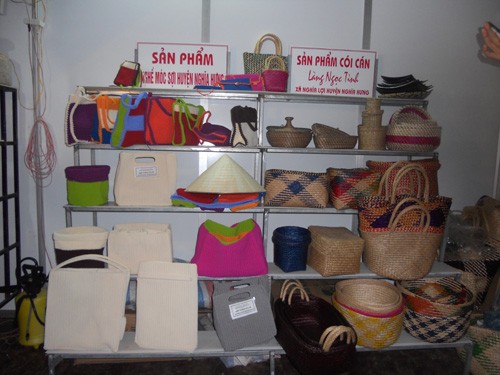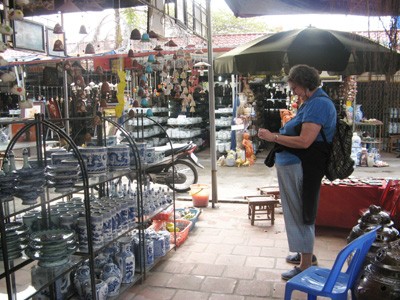(VOVworld) – Vietnam’s traditional handicrafts are associated with wet rice civilization and craft villages and guilds. Handicrafts not only turn a profit but also reflect the customs and culture of Vietnam’s rural areas. On today’s edition of Colorful Vietnam-Vietnam’s 54 ethnic groups, VOV reporter To Tuan examines the traditional handicrafts of Vietnam.
Vietnam’s traditional handicraft villages are concentrated in the Red River Delta. The ancient Viet people lived mainly on rice farming. During the idle time between crops, farmers made tools of bamboo, rattan and steel. As time went by, handicrafts developed from households to guilds. Whole villages engaged in pottery, mat weaving, silk weaving, wood-carving or bronze casting.
 |
| Rattan and sedge products made by villagers in Nam Dinh |
Hanoi, Vietnam’s capital city with a thousand-year history boasts many handicraft streets and guilds. The city has 36 streets whose name begins with the word “Hang” meaning “Craft”. Craftspeople from rural areas moved to Hanoi and formed their guilds. Today, some of these streets retain their traditional crafts, such as Hang Bac – engaged in silver making, Hang Thiec – Tin making, and Hang Dong – Bronze-casting. Some retain their old name but the traditional crafts faded such as Hang Can – Scale making, and Hang Quatt – Fan making. Folklore researcher Doctor Ngo Duc Thinh says: “Hang Quat street no longer makes fans, but it reminds people of a traditional craft that is reflected in the local lifestyles and architecture”.
 |
| Silver carving demonstration in Hang Bac street, Hanoi |
Each craft village has its own know-how, which has been passed down from generation to generation. There have been villages specialized in lacquer wares, pottery, blacksmithing, embroidery, bamboo, rattan, basket-weaving, folk painting and wooden and stone sculpture. Nguyen Huu Nam is the owner of a workshop of doing gold and silver inlays in Kieu Ky village on the outskirts of Hanoi: “We inherited this craft from our ancestors. We have mastered the techniques of gold and silver inlaying and transferred them to our offspring”.
Traditional craft villages have cultural and historical significance. Many of them have become popular tourist destinations.
 |
| The pottery village of Bat Trang attracts foreign visitors |
Vietnam now has 4,500 craft villages, including 400 traditional villages which employ some 12 million people and create millions of seasonal jobs for farmers. The export of handicraft items earns more than 1 billion USD annually. These villages generate economic benefits while helping to preserve Vietnam’s cultural and historical heritage.